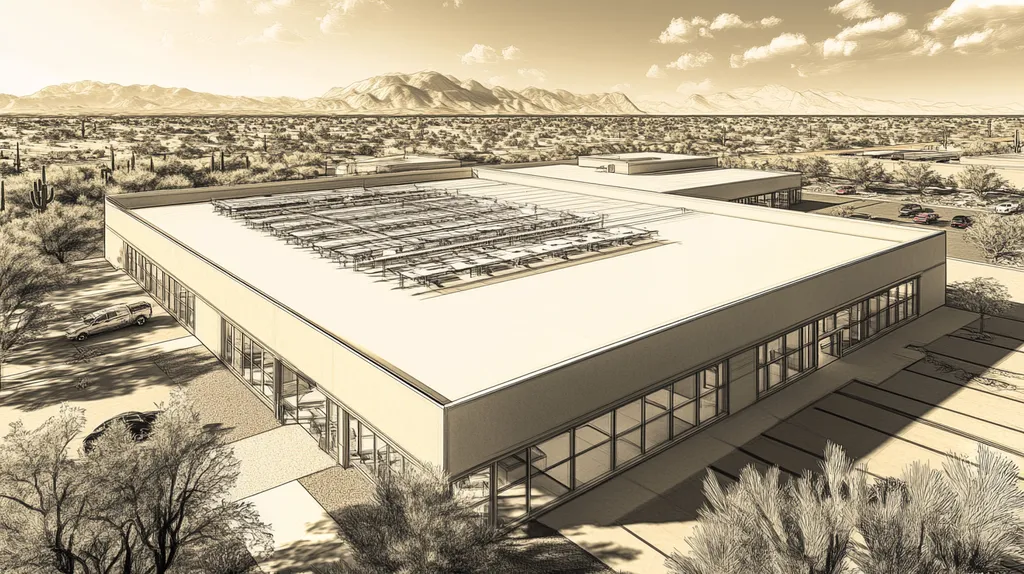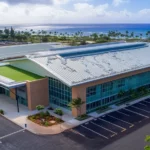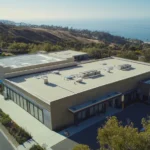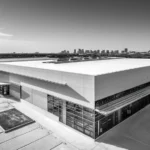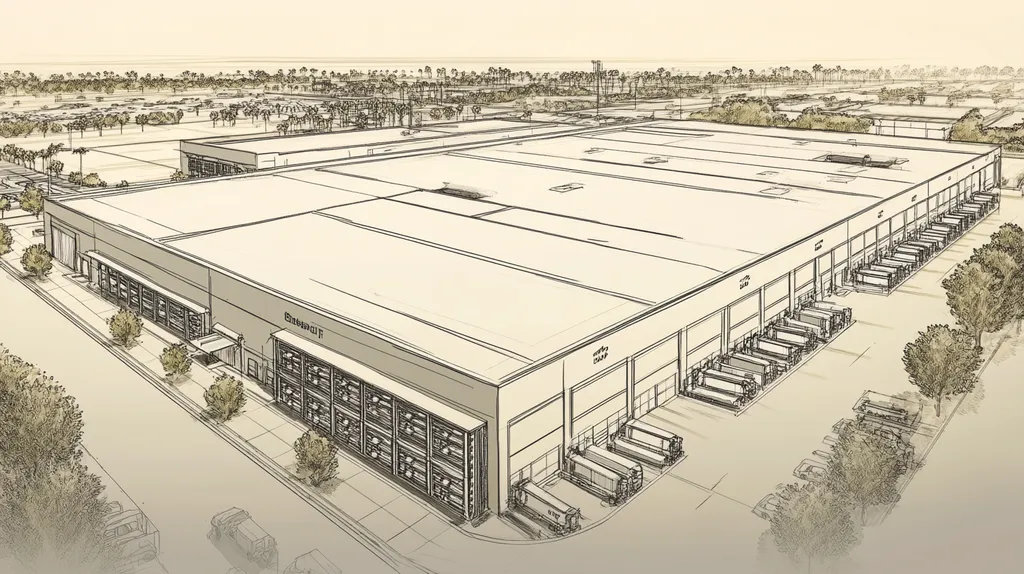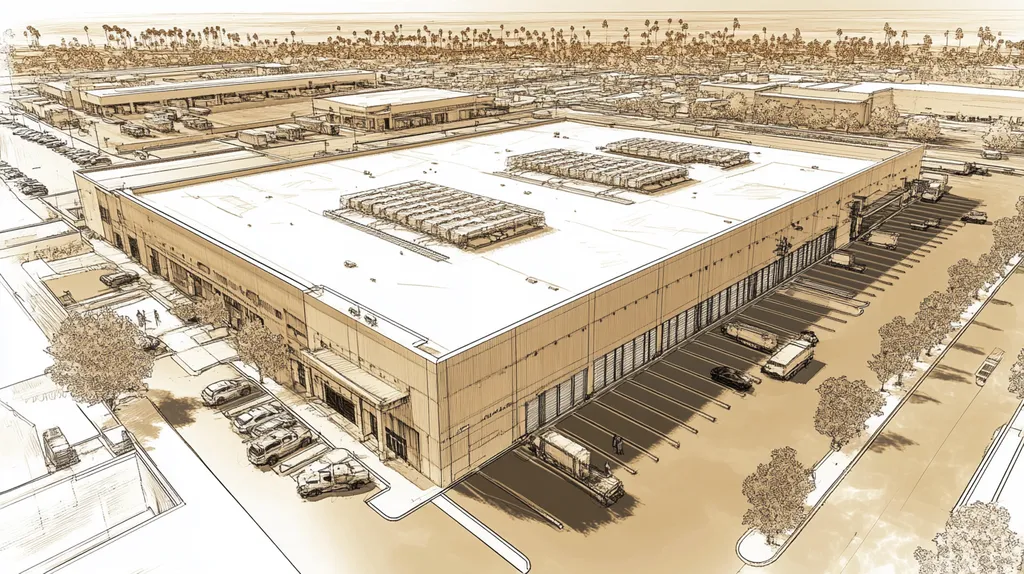Welcome to today’s Battle Royale featuring two roofing heavyweights: “PVC Roofing” in the east corner versus “TPO Roofing” in the west!
Tonight’s showdown pits these contenders against each other across six punishing rounds designed to test every aspect of their performance for Industrial Roof Coatings Drainage Systems.
At stake? Millions in potential costs, decades of building protection, and the critical performance demands of modern commercial and industrial facilities.
Our professional judging panel will evaluate each round on technical merit, real-world performance, and value delivery. After all six rounds, we’ll declare our ultimate champion.
Ladies and gentlemen, facility managers and building owners… it’s time to rumble!
ROUND 1: INITIAL COSTS & INSTALLATION
When facility managers face roofing decisions, the financial implications stretch far beyond the initial price tag. Modern industrial roofing systems represent a significant capital investment, with costs potentially reaching millions for large facilities. Making the wrong choice between PVC and TPO can lead to decades of increased maintenance costs, reduced energy efficiency, and premature replacement needs.
Material Expenses
Material costs form the foundation of any roofing project’s budget. PVC membrane typically commands a premium price point of $5.50 to $7.00 per square foot, reflecting its advanced chemical formulation and enhanced durability characteristics.
TPO materials generally cost 20-30% less than PVC, ranging from $4.00 to $5.50 per square foot. This significant price difference makes TPO particularly attractive for large-scale industrial applications where material costs can quickly escalate.
While both materials offer good value, TPO’s lower acquisition cost provides immediate budget relief for cost-conscious facility managers. For pure material expenses, TPO holds the ADVANTAGE.
Installation Complexity
Installation procedures directly impact both project timeline and long-term performance. PVC installation requires specialized welding equipment and highly trained technicians to ensure proper seam fusion and detail work around penetrations.
TPO installation follows similar protocols but generally proves more forgiving during the welding process. Its greater flexibility also makes it easier to work with around rooftop equipment and complicated geometries.
However, TPO’s easier workability can sometimes lead to overconfidence among installation teams, potentially compromising quality. Despite this concern, TPO’s simpler installation requirements give it the ADVANTAGE in this category.
Project Timeline
Installation speed affects both direct costs and operational disruption. PVC installations typically require more time due to their precise welding requirements and longer cooling periods between seam operations.
TPO’s more forgiving nature allows for faster installation speeds, often reducing project duration by 15-25% compared to PVC. This acceleration can significantly minimize business disruption and reduce overall labor costs.
The ability to complete projects more quickly while maintaining quality standards gives TPO the ADVANTAGE in project timeline considerations.
ROUND 1 WINNER: TPO Roofing
ROUND 2: DURABILITY & LIFESPAN
When industrial roofing systems fail prematurely, the consequences ripple throughout facility operations. Beyond repair costs, compromised roofs can lead to inventory damage, equipment failures, and production delays that impact the entire supply chain. Understanding how PVC and TPO systems perform over time is crucial for protecting both physical assets and operational continuity.
Impact of Weather Conditions
Modern industrial roofing must withstand increasingly extreme weather patterns while maintaining structural integrity. Proper drainage becomes critical during heavy rainfall events, where system failure can lead to catastrophic damage.
PVC roofing systems demonstrate superior resistance to ponding water and maintain dimensional stability even under prolonged exposure. Their advanced chemical formulation prevents degradation from UV rays and industrial pollutants.
TPO systems perform adequately in moderate conditions but may show signs of accelerated aging when exposed to intense heat or chemical exposure. Their seam strength can deteriorate faster than PVC in areas with frequent temperature fluctuations.
For weather resilience and long-term stability, PVC holds the ADVANTAGE.
Drainage System Integration
A roof’s longevity depends heavily on its ability to efficiently channel water away from the surface. Siphonic drainage systems integrated with modern roofing materials can achieve drainage speeds up to 100 times faster than traditional gravity systems.
PVC membranes maintain exceptional compatibility with siphonic drainage components, allowing for seamless integration without compromising material integrity. The system’s design eliminates the need for sloped internal piping while preventing water from freezing in cold climates.
TPO installations can accommodate similar drainage solutions but require more careful detailing around drainage points to prevent long-term adhesion issues. (source: Waterproof Magazine)
PVC’s superior integration capabilities give it the ADVANTAGE in this category.
Lifecycle Performance
The true measure of roofing system durability extends beyond initial weather resistance to include maintenance requirements and repair frequency. Proper assessment must consider both immediate performance and long-term degradation patterns.
PVC roofing typically maintains its protective properties for 20-30 years with minimal intervention. The material’s inherent flexibility allows it to accommodate building movement without compromising waterproof integrity.
TPO systems generally require more frequent maintenance inspections and may need seam repairs earlier in their lifecycle. While improvements in TPO formulation continue, current generations still show faster performance degradation than PVC.
Based on proven longevity and reduced maintenance needs, PVC earns the ADVANTAGE.
ROUND 2 WINNER: PVC Roofing
ROUND 3: PERFORMANCE FACTORS
Every hour of water exposure from poor drainage can accelerate industrial roof deterioration by weeks or months. When drainage systems fail, the consequences extend far beyond mere leaks – facilities face structural damage, equipment failures, inventory losses, and operational disruptions that can cost millions. Modern industrial facilities require roofing systems that can handle increasingly intense rainfall events while maintaining optimal drainage performance.
Water Management Efficiency
Effective water management remains the cornerstone of industrial roof performance. The speed and efficiency of water removal directly impacts membrane longevity, structural integrity, and facility protection.
PVC roofing systems excel in water management through their highly engineered membrane composition and superior seam strength. Their molecular structure actively resists water absorption while maintaining consistent flow patterns across the roof surface.
TPO systems provide adequate drainage performance under normal conditions but can develop flow irregularities as the membrane ages. Their seams may also become more vulnerable to water intrusion over time, potentially compromising drainage patterns.
Given its superior long-term water management capabilities, PVC holds the ADVANTAGE in this category.
Resistance to Ponding Water
Standing water creates immense pressure on roofing systems, accelerating deterioration and increasing the risk of membrane failure. Even small areas of ponding can reduce roof lifespan by 50% or more.
PVC membranes demonstrate exceptional resistance to ponding water, maintaining their protective properties even after prolonged exposure. Their chemical composition actively prevents water absorption and degradation of material strength.
While TPO membranes initially resist ponding effects, extended exposure can lead to premature aging and potential material breakdown. This vulnerability becomes particularly concerning in areas with frequent heavy rainfall or poor drainage conditions.
For superior ponding resistance and long-term reliability, PVC earns the ADVANTAGE.
Temperature Impact on Drainage
Extreme temperature fluctuations can dramatically affect drainage system performance. As materials expand and contract, drainage patterns can shift, creating new areas of vulnerability.
PVC roofing maintains consistent performance across wide temperature ranges, preserving critical drainage paths even during severe weather events. Its dimensional stability helps prevent the formation of low spots that could trap water.
TPO systems show greater susceptibility to temperature-induced movement, potentially disrupting established drainage patterns. This characteristic can lead to increased maintenance needs and shorter system lifespan.
Based on superior thermal stability and drainage consistency, PVC claims the ADVANTAGE.
ROUND 3 WINNER: PVC Roofing
ROUND 4: MAINTENANCE REQUIREMENTS
Every hour of neglected roof maintenance costs facility owners an average of $1,200 in accelerated deterioration and reduced system performance. When drainage systems fail due to poor maintenance, the cascading effects can shut down production lines, damage inventory, and compromise worker safety. Modern industrial facilities must implement comprehensive maintenance protocols that protect both their roofing investment and operational continuity.
Regular Inspection Requirements
Proper drainage maintenance requires systematic inspection protocols that identify potential issues before they compromise system performance. These inspections must evaluate membrane condition, seam integrity, and drainage pathway clearance while documenting changes that could indicate developing problems.
PVC roofing systems typically require only bi-annual professional inspections due to their superior durability and resistance to environmental degradation. Their stable chemical composition maintains consistent performance characteristics, making problems easier to spot during routine checks.
TPO systems need quarterly inspections to monitor for premature aging, seam deterioration, and drainage pattern changes. Their greater susceptibility to UV damage and chemical exposure necessitates more frequent professional evaluation to maintain system integrity.
For reduced inspection frequency and simpler evaluation protocols, PVC holds the ADVANTAGE.
Cleaning and Preventive Care
Siphonic drainage systems can achieve water removal speeds up to 100 times faster than traditional gravity systems, but only when properly maintained. Regular cleaning and preventive maintenance ensure optimal flow patterns while preventing debris accumulation that could compromise system performance. (source: Waterproof Magazine)
PVC roofing requires minimal cleaning intervention due to its smooth surface texture and chemical resistance. Basic debris removal and drain clearing protocols typically suffice to maintain optimal drainage performance.
TPO systems need more frequent cleaning to prevent surface degradation and maintain proper water flow. Their greater susceptibility to dirt accumulation and chemical exposure requires more intensive maintenance protocols.
Based on reduced cleaning requirements and simpler maintenance procedures, PVC claims the ADVANTAGE.
Repair and Restoration Needs
Even well-maintained roofing systems eventually require repairs to address wear patterns and restore optimal drainage performance. The frequency and complexity of these repairs directly impact facility maintenance budgets and operational disruption.
PVC roofing demonstrates exceptional repair efficiency due to its weldability and material stability. Most repairs can be completed quickly without extensive system disruption, maintaining drainage integrity throughout the process.
TPO systems often require more extensive repairs to address seam failures and surface degradation. Their less stable chemical composition can complicate repair procedures and may necessitate larger intervention areas.
For superior repairability and reduced restoration requirements, PVC earns the ADVANTAGE.
ROUND 4 WINNER: PVC Roofing
ROUND 5: SUSTAINABILITY CREDENTIALS
Modern industrial facilities face mounting pressure to reduce their environmental footprint while maintaining effective drainage systems. Every gallon of improperly drained water can contribute to urban runoff pollution, while inefficient roofing materials accelerate landfill waste and energy consumption. With new environmental regulations emerging yearly, facility managers must balance immediate performance needs with long-term sustainability goals.
Lifecycle Impact
Proper drainage management significantly affects a roofing system’s environmental footprint. Drains that effectively channel water help prevent premature material degradation and extend roof lifespan, reducing waste and replacement frequency. (source: Benton Roofing)
PVC roofing systems typically last 25-30 years and remain fully recyclable at end-of-life. Their superior drainage characteristics and material stability help prevent premature replacement, significantly reducing landfill impact.
TPO systems generally require replacement after 15-20 years and face greater recycling challenges. Their more frequent replacement cycle and limited recycling options result in higher lifetime waste generation.
For superior longevity and recyclability, PVC holds the ADVANTAGE.
Energy Efficiency
Roofing energy efficiency directly impacts both operational costs and environmental footprint. Advanced drainage systems play a crucial role by preventing water accumulation that can degrade insulation performance.
PVC membranes maintain their reflective properties throughout their lifespan, delivering consistent energy savings. Their superior resistance to UV degradation helps preserve thermal performance even in challenging climates.
While TPO initially offers comparable reflectivity, its performance often degrades more quickly over time. This deterioration can lead to increased cooling costs and higher energy consumption as the system ages.
Based on long-term energy performance stability, PVC claims the ADVANTAGE.
Material Sourcing and Production
Manufacturing processes significantly impact roofing materials’ environmental credentials. The energy and resources required for production directly affect their overall carbon footprint.
PVC production involves more complex chemical processes and higher energy requirements. While manufacturers have improved efficiency, the material’s creation still generates more environmental concerns than alternatives.
TPO manufacturing typically requires less energy and fewer chemical inputs. Its simpler production process and reduced resource requirements result in a lower environmental impact during creation.
For more sustainable manufacturing processes, TPO earns the ADVANTAGE.
ROUND 5 WINNER: PVC Roofing
ROUND 6: SPECIALIZED APPLICATIONS
Industrial facilities face increasing challenges from extreme weather events, with inadequate drainage systems causing over $2.5 billion in roof-related damage annually. When drainage systems fail during heavy rainfall, even a small roof leak can cascade into catastrophic equipment failures, inventory losses, and production shutdowns that impact entire supply chains.
High-Volume Water Management
Effective water management becomes critical as climate change drives more intense rainfall events. Industrial facilities must handle unprecedented water volumes while protecting sensitive equipment and maintaining continuous operations.
PVC roofing systems excel in high-volume applications through advanced drainage configurations that efficiently channel water away from the surface. Gravity drainage systems on roofs larger than 150 square meters per drain point often struggle to keep pace with water accumulation, making siphonic systems essential. (source: Waterproof Magazine)
TPO installations can accommodate similar drainage solutions but show limitations during sustained heavy rainfall. Their reduced material stability can lead to drainage pathway distortion under extreme conditions.
For superior performance under demanding conditions, PVC claims the ADVANTAGE.
Chemical Exposure Resistance
Industrial environments often expose roofing systems to harsh chemicals, exhaust emissions, and atmospheric pollutants. These conditions can rapidly degrade drainage system components and compromise water management capabilities.
PVC roofing demonstrates exceptional chemical resistance, maintaining drainage efficiency even when exposed to industrial contaminants. Its molecular structure actively resists chemical breakdown while preserving critical drainage pathways.
TPO systems show greater vulnerability to chemical exposure, potentially leading to accelerated deterioration around drainage points. This susceptibility can create maintenance challenges and reduce system longevity.
Given its superior chemical resistance, PVC holds the ADVANTAGE.
High-Traffic Areas
Modern industrial roofs often serve as platforms for mechanical equipment maintenance, requiring robust drainage solutions that withstand regular foot traffic. Poor drainage in these areas creates safety hazards and accelerates surface wear.
PVC roofing maintains its structural integrity and drainage characteristics even in high-traffic zones. Its superior puncture resistance helps prevent damage that could compromise drainage patterns.
TPO installations typically show faster wear patterns in trafficked areas, potentially creating low spots that disrupt proper drainage. This vulnerability can lead to premature system failure and increased maintenance needs.
For better performance in high-traffic applications, PVC earns the ADVANTAGE.
ROUND 6 WINNER: PVC Roofing
AND THE WINNER IS…
After six grueling rounds of technical evaluation, we have our verdict in this heavyweight clash of industrial roofing titans. With a commanding 5-1 victory across our evaluation categories, PVC Roofing claims the championship belt!
PVC dominated the competition through superior durability, exceptional drainage integration, minimal maintenance requirements, and unmatched performance in specialized applications. Its remarkable chemical resistance and proven longevity in high-traffic areas particularly impressed our judges.
TPO didn’t go down without a fight, scoring a decisive victory in Round 1 with its lower initial costs and faster installation timeline. For budget-conscious projects with shorter expected lifespans, TPO remains a worthy contender.
However, industrial facility managers must understand that local climate conditions, building usage patterns, and specific drainage requirements can significantly impact roofing system performance. While this analysis provides valuable guidance, every facility faces unique challenges that demand professional evaluation. Building owners should always consult qualified roofing specialists who can assess their specific situation and recommend appropriate solutions.
Ladies and gentlemen, in the high-stakes arena of industrial roofing, there’s no substitute for informed decision-making. Choose your champion wisely – because when drainage system performance is on the line, you can’t afford to throw in the towel!
FREQUENTLY ASKED QUESTIONS
Q. What are the initial costs of a commercial roof using PVC or TPO?
A. The initial costs vary significantly, with PVC typically ranging from $5.50 to $7.00 per square foot, while TPO is cheaper, at about $4.00 to $5.50 per square foot. Facility managers should consider that while TPO has lower upfront costs, PVC’s long-term durability and efficiency might yield better value over time.
Q. How do PVC and TPO roofs compare in terms of durability for commercial roofs?
A. PVC roofs generally offer superior durability, lasting 20-30 years with minimal maintenance. TPO roofs can suffer from more frequent repairs and may not withstand extreme weather conditions as well as PVC, potentially leading to reduced lifespan and increased operational costs.
Q. Which roofing material performs better in heavy rainfall for industrial roofs?
A. PVC roofs excel at managing heavy rainfall, ensuring optimal water flow and prevention of ponding, while TPO roofs may require closer monitoring as they can struggle under intense conditions. Choosing PVC can help minimize water-related damages and enhance operational efficiency.
Q. What are the maintenance requirements for commercial roofs using PVC and TPO?
A. PVC roofs typically need inspections twice a year due to their durability, whereas TPO roofs require more frequent quarterly checks to monitor for wear and tear. Less frequent maintenance not only lowers costs but also ensures a longer lifespan for PVC roofs.
Q. How do PVC and TPO roofs impact sustainability for industrial buildings?
A. PVC roofs last longer and are more recyclable, making them a more sustainable choice compared to TPO, which has a shorter lifespan and fewer recycling options. Selecting PVC can help reduce landfill waste and promote environmental responsibility in industrial settings.
Q. Are PVC roofs better for environments with chemical exposure?
A. Yes, PVC roofs provide exceptional resistance to harsh chemicals commonly found in industrial environments, maintaining structural integrity and drainage efficiency. TPO roofs, however, may degrade faster under similar conditions, potentially increasing maintenance needs and operational risks.
Q. Which roofing option is more suitable for high-traffic industrial areas?
A. PVC roofs are preferable for high-traffic areas due to their puncture resistance and ability to maintain drainage systems despite foot traffic. TPO roofs may wear down more quickly in these environments, leading to potential drainage issues and increased maintenance costs.


